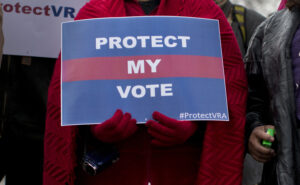‘Right Out of California’ Book Review: On the Big Business Roots of Modern Conservatism
In her look at California labor disputes during the Depression, Kathryn Olmsted reveals a mirror reflected across eight decades: Even the government's most modest policies on behalf of the poor were met with hysteria by the right.

The New Press
|
To see long excerpts from “Right Out of California” at Google Books, click here. |
“Right Out of California: The 1930s and the Big Business Roots of Modern Conservatism” A book by Kathryn S. Olmsted
On a January evening in 1934, an attorney with the ACLU named A.L. Wirin was due to speak in Brawley, a small city in the vast desert east of San Diego. His subject was the U.S. Constitution and the right of workers to strike. Wirin’s was not an academic lecture: Two weeks earlier, 5,000 lettuce workers — the vast majority from Mexico — had refused to enter the fields surrounding Brawley, demanding 35 cents an hour (the equivalent of about $6 today). In response, police arrested strikers, and vigilantes broke up rallies with tear gas and clubs, while labor organizers darted from one worker’s home to the next, trying to both maintain morale and stay alive. “If you checked into a hotel in Brawley, no matter what name you used, you were sticking your neck into a noose,” recalled Pat Chambers, one of the most talented farmworker organizers of the period.
Wirin arrived in Brawley and checked into a hotel. After he sat down for dinner, a group of armed men approached his table, dragged him to a waiting car, and drove off into the desert, where they beat him, stole his wallet, tied his hands behind his back, and, before leaving, stripped him of his shoes. Among the assailants was a member of the California Highway Patrol who didn’t even bother to change out of his uniform. Left alone, barefoot and bloodied, Wirin hobbled along the road, looking for help. The attorney had learned there was no right to strike in Brawley. There wasn’t even the right to talk about the right to strike.
As Kathryn Olmsted documents in her gripping book, “Right Out of California: The 1930s and the Big Business Roots of Modern Conservatism,” conditions in the Depression-era fields of California were brutal — and especially so for farmworkers who dared to band together into unions. Labor camps were burned to the ground and organizers jailed on the flimsiest of charges; even two agents of the federal government, sent to investigate the conflict in the Imperial Valley, were arrested by the local police chief. “We don’t want conciliation,” the chief told them. “We know how to handle these people and where we find trouble makers we will drive them out.”
There would be little conciliation. During the 1930s, more than 125,000 California farmworkers engaged in at least 140 strikes. Yet by the end of the decade, growers and their political allies would beat back unionization efforts, sending many organizers to jail on criminal conspiracy charges. Earlier historians have documented some of these conflicts, where the sort of heavy-handed repression that occurred in Brawley was common. But Olmsted breaks new ground by connecting these battles to other statewide rebellions — Upton Sinclair’s near-victory for governor, the San Francisco general strike — to argue that the modern conservative movement was born out of these campaigns, as growers learned to press sensitive cultural buttons, use dark money to push their cause, and portray the federal government as a nefarious, creeping force. “Business leaders,” Olmsted writes, “understood that they had to persuade people that Franklin Roosevelt’s administration imperiled their religion, their liberty, and their family — their very way of life as they knew it.”
In truth, the federal government didn’t do all that much to help farmworkers. The National Industrial Recovery Act of 1933 protected the rights of workers to form unions and bargain collectively; those rights, however, did not apply to farmworkers. But if New Deal protections largely excluded farmworkers, their programs provided a lifeline for growers, as the government offered subsidies and loans, while also using taxpayer money to build the dams and irrigation canals that allowed a place like the Imperial Valley to become a winter wonderland for crops. Growers, as Olmsted notes, had no problem with the government meddling in the market, as long as it was to their benefit. But when Roosevelt authorized shipments of food to striking cotton workers in 1933 — in what remains the largest agricultural strike in U.S. history — they became outraged, convinced the hand of Communism was at work.
As the decade progressed, and workers continued to organize, frightened growers recalibrated their message, mobilizing around gender, racial and sexual anxieties while exploiting fears about Communism. Organizers might call for a “fair wage,” but what they really wanted, as one grower-sponsored speaker argued, was to remake the country in the image of the Soviet Union, where free love reigned, cannibalism was practiced, and “droves of wild homeless children live in sewers.” While shifting from the economic to the cultural/family front, growers were careful to cover their tracks. As one representative of the Chamber of Commerce noted, the funding “should be kept a deep, dark secret. This is the only way you can win the fight.” Growers and their allies discovered another way to win: surveillance. One of the most fascinating characters in Olmsted’s book is Gen. Ralph Van Deman. A legendary figure in the history of military intelligence, Van Deman honed his skills fighting insurgents in the Philippines before retiring to set up a massive intelligence gathering operation out of his San Diego home. His files grew to cover some 125,000 “subversive” groups and individuals in California — which included the American Federation of Labor and the YMCA — and he collaborated extensively with growers, who created their own spying and surveillance arms to track down organizers and break strikes.
Growers were obsessed with two organizers in particular: Pat Chambers and Caroline Decker. Their names pop up in books about the period, but Olmsted fills in new biographical details about the pair, who were hounded across the state by law enforcement and often forced to operate underground. Both were white, spoke little Spanish, and were members of the Communist Party, though neither cared much for Marxist theory; they were interested in organizing farmworkers, and were willing to suffer for it. “These people seen that we didn’t have anything, we didn’t have ulterior motives,” Chambers said. “We had less than they had. If they went hungry, we went hungry.”
Chambers came out of the Irish-American working class, while Decker was from a middle-class Jewish family (her last name was actually Dwofsky). She had joined the Youth Communist League in Syracuse and organized coal miners in Kentucky before landing in California. Unlike the plainspoken Chambers, she was a gifted public speaker and, with her fashionable dresses and high heels, a curious presence on the picket line. While they were seen as the driving force behind the 1933 cotton strike, it was the mostly Mexican workforce that had pulled it off. But growers found it difficult to imagine brown-skinned workers acting on their own, and decided the two organizers needed to be taken care of.
They got their chance the following year. By now, Decker and Chambers had relocated the union’s office from San Jose to Sacramento — a lynch mob had strung up a San Jose man several blocks from their office, and they feared being the next target. The duo continued to organize small marches and protests. The district attorney ordered a raid of the Communist Party headquarters, arresting 24 people for vagrancy, including the two star organizers. Soon the charges were updated to criminal syndicalism. The resulting trial was front-page news for weeks, and Olmsted dedicates a chapter to this largely forgotten episode, in which growers essentially paid for a verdict that sent the organizers to prison for five years. “State has farm peace,” ran the headline in the Los Angeles Times.
For readers interested in the history of California radicalism — and reaction — Olmsted’s book covers fascinating new ground and offers an intriguing, and ultimately convincing, thesis. It is also something of a mirror reflected across eight decades. At a time of extreme inequality, even the government’s most modest policies on behalf of the poor — shipments of free food, the construction of a handful of labor camps — were met with hysteria by the right. There is a photograph in the book of four Los Angeles “churchwomen” holding pistols as they take target practice. The image is from 1935, and the ladies are identified as members of American Women, Inc., a group who believed that Roosevelt was pushing as “Communist a policy as the Russian government’s own economic program” and who were prepared to lay their lives on the line to save their country. As Wallace Stegner once remarked, “California is America, only more so.”
Gabriel Thompson has written for The New York Times, New York, The Nation and Mother Jones. His most recent book is “Working in the Shadows: A Year of Doing the Jobs (Most) Americans Won’t Do.”
Independent journalism is under threat and overshadowed by heavily funded mainstream media.
You can help level the playing field. Become a member.
Your tax-deductible contribution keeps us digging beneath the headlines to give you thought-provoking, investigative reporting and analysis that unearths what's really happening- without compromise.
Give today to support our courageous, independent journalists.






You need to be a supporter to comment.
There are currently no responses to this article.
Be the first to respond.